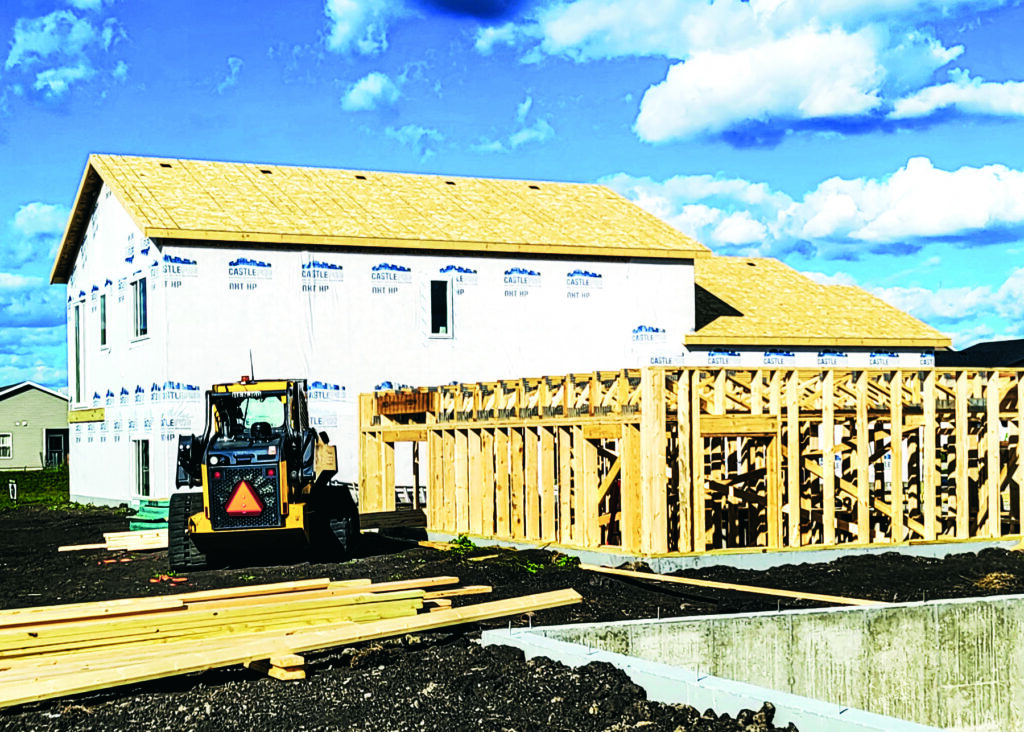
Construction of single-family homes is nearly on par with Moorhead’s total of 108 in 2021. The “Make Moorhead Home” two-year property tax rebate keeps the city competitive with its neighbors west of the Red River. (Photos/Nancy Hanson.)
Nancy Edmonds Hanson
Why build your new home in Moorhead?
“We have a growing school system and great neighborhoods,” governmental affairs director Lisa Bode points out. “Moorhead’s flood protection is another important factor home buyers consider when they weigh their options.”
But when you ponder the upsurge over the past 10 years – one that has seen more than 1,350 new single-family homes built in the past 10 years, one particular factor stands out: the citywide program called “Make Moorhead Home.”
When a family builds a new residence in the city, their first two full years of property taxes are rebated. They do pay the taxes levied by the city, the Moorhead School District and Clay County. But then they receive a check back for the full amount. Only in the third year after the home is completed do they pay their full tax load, joining the city’s taxable residential property base.
The city council renewed the two-year tax rebate program for a sixth time at a meeting in mid-September. That means the rebate will continue to apply to all homes completed through the end of 2024.
In 2021, the most recent year for which data is complete, construction of 108 new single-family homes was begun in Moorhead. That number was down somewhat, reports planning director Kristie Leshovsky, from the yearly average of 156 since 2012, when “Make Moorhead Home” was introduced. “But generally it’s been pretty steady,” she observes, citing Covid-related factors like rising costs of construction materials, labor shortages and supply chain issues as probably causes. “It takes some time to build back,” she notes.
Yet the numbers Bode reported to the council when advocating renewing the “Make Moorhead Home” rebate illustrate the success of the program, which is funded by the city, school district and county. The homes built during MMH, as the program is called for short, have added taxable value of more than $390 million to the city’s base, generating tax revenues of more than $6 million per year. “Our staff hears from housing industry professionals that the tax rebate on new construction is an important consideration for new home buyers as they decide where to build,” she says, “and we also hear directly from home buyers that the rebate was an important consideration.”
This year, rebates are being made to owners of 125 homes completed in 2019 and 123 more finished in 2020. These homes alone added approximately $63.7 million in value to Moorhead’s total property. The tax rebates will amount to about $827,000. “However,” she stresses, these homes will be paying taxes this much in taxes or more for every single year in the future.”
Fargo and West Fargo have offered similar tax incentives since the 1980s. For Moorhead, the move was spurred by two dark moments in its record books – the floods of 1997 and 2009-2010.
“In 1997 we were successful in holding back the flood. We lost only nine homes,” she recounts the story. “But East Grand Forks and Breckenridge were devastated. The state offered a low-interest mortgage program to assist in their recovery, but they left us out. They said, ‘You weren’t damaged,’ even though we argued we had major damage to the market for homes here. Sales went down dramatically because of the perceived risk.”
When the Red River reached record levels in 2009 and flooded again in 2010, the city’s leaders were ready. “We remembered what happened and asked the Legislature for a state-funded tax exemption,” she says. “It did help with our recovery.”
Begun in 2009 and renewed the next year, the state program ended in 2011. Pleased with the results, the city took over the program itself along with the school district and county. Branded “Make Moorhead Home,” it helped set off a groundswell of home building over the following years, with the highest number to date – 197 – in 2015.
Leshovsky point to the need for the turn-around. “According to the U.S. Census, the only decade in which Moorhead has ever actually lost population was from 1990 to 2000,” she says. After initiating the tax rebate program, growth took off between 2010 and the most recent census in 2020, growing about 21% from 37,000 to 44,500. Leshovsky points out that in that statewide count, Moorhead was ranked the fastest growing city in Minnesota outside of the Twin Cities.
Bode concedes that no single factor is entirely responsible for that growth. “There have been a lot of things. Flood control. Our new schools. Everybody has been working together.”
Leshovky adds, “We strongly believe Moorhead offers great value. We do have strong competition in other high-growth areas.” She mentions Horace, where building permits have risen from 25 in 2018 to 153 in 2022.
But with attractive new developments beginning to blossom, like Prairie Parkway just east of Southside Regional Park on 40th Avenue South and the newly platted Preserve on Broadway in the Oakport area, there’s plenty of interest in calling Moorhead home.
“We’re trying to build great neighborhoods and make this a place where people want to live, raise their families and open businesses,” the city planner says. She adds that the cost of the property tax rebates is one the city can afford. “We’re going from bare lots to homes that are going to be part of our residential tax base forever,” she adds. “All it costs is a two-year delay.”


